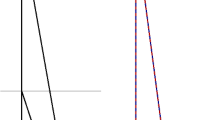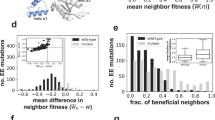Abstract
Through comparative studies of DNA sequences it has become possible to test the neutral and the selection theories of molecular evolution. The separate estimation of the numbers of synonymous and nonsyn-onymous substitutions is one of the most powerful tools for detecting selection. The patterns on the average and variance of these two types of substitutions of mammalian genes turned out to be in accord with the slightly deleterious or the nearly neutral mutation theory for nonsynonymous changes. Interactive systems at the amino acid level were suggested to be responsible for such nearly neutral or very weak selection. An attractive model is the NK model of Kauffman, which assumes that each amino acid makes a fitness contribution that depends upon the amino acid and upon K other amino acids among the N that make the protein. It is known that the fitness landscape is very rugged for K ≥ 2. Population genetic analysis of this model suggest that protein evolution obeys the nearly neutral theory and that random genetic drift is important. In other words, evolution becomes rapid in small populations because proportion of near-neutrality increases among new mutations, and proteins as interactive systems evolve by shifting through random genetic drift on the multipeaked fitness landscape.
Similar content being viewed by others
References
Ballard JWO, Kreitman M (1994) Unraveling selection in the mitochondrial genome of Drosophila. Genetics 138:757–772
Bulmer M (1991) The selection-mutation-drift theory of synonymous codon usage. Genetics 129:897–907
Chao L, Carr DE (1993) The molecular clock and the relationship between population size and generation time. Evolution 47:688–690
Charlesworth B, Morgan MT, Charlesworth D (1993) The effect of deleterious mutations on neutral molecular variation. Genetics 34: 1289–1303
Eanes WF, Kirchner M, Yoon J (1993) Evidence for adaptive evolution of the G6pd gene in the Drosophila melanogaster and Drosophila simulans lineages. Proc Natl Acad Sci USA 90:7475–7479
Gillespie JH (1984) Molecular evolution over the mutational landscape. Evolution 38:1116–1129
Gillespie JH (1987) Molecular evolution and the neutral allele theory. Oxf Surv Evol Biol 4:10–37
Gillespie JH (1991) The causes of molecular evolution. Oxford University Press, Oxford
Gillespie JH (1994) Substitution processes in molecular evolution. III. Deleterious alleles. Genetics 138:943–952
Goldman N (1994) Variance to mean ratio, R(t), for Poisson processes on phylogenetic trees. Mol Phyl Evol 3:230–239
Ina Y (1995) New methods for estimating the numbers of synonymous and nonsynonymous substitutions. J Mol Evol 40:190–226
Kaplan N, Hudson RR, Langley CH (1989) The ‘hitchhiking effect’ revisited. Genetics 123:887–899
Kauffman SA (1993) The origins of order. Oxford University Press, Oxford
Kimura M (1968) Evolutionary rate at the molecular level. Nature 217:624–626
Kingman JFC (1978) A simple model for the balance between selection and mutation. J Appl Probab 15:1–12
Kliman RM, Hey J (1993) DNA sequence variation at the period locus within and among species of the Drosophila melanogaster complex. Genetics 133:375–387
Langley CH, Fitch WM (1974) An examination of the constancy of the rate of molecular evolution. J Mol Evol 3:161–177
Long M, Langley CH (1993) Natural selection and the origin of jingwei, a chimeric processed functional gene in Drosophila. Science 260:91–95
McDonald JH, Kreitman M (1991) Adaptive protein evolution at the Adh locus in Drosophila. Nature 351:652–654
Miyashita NT, Innan H, Terauchi R (1996) Intra- and interspecific variation of alcohol dehydrogenase locus region in wild plants Arabis gemmifera and Arabidopsis thaliana. Mol Biol Evol 13:433–436
Nachman MW, Boyer SN, Aquadro CF (1994) Nonneutral evolution at the mitochondrial NADH dehydrogenase subunit 3 gene in mice. Proc Natl Acad Sci USA 91:6364–6368
Nachman MW, Brown WM, Stoneking M, Aquadro CF (1996) Nonneutral mitochondrial DNA variation in humans and chimpanzees. Genetics 143:953–963
Ohta T (1973) Slightly deleterious mutant substitutions in evolution Nature 246:96–98
Ohta T (1977) Extension to the neutral mutation random drift hypothesis. In: Kimura M (ed) Molecular evolution and polymorphism. National Institute of Genetics, Mishima, pp 148–167
Ohta T (1991) Multigene families and the evolution of complexity. J Mol Evol 33:34–41
Ohta T (1992) The nearly neutral theory of molecular evolution. Annu Rev Ecol Syst 23:263–286
Ohta T (1995) Synonymous and nonsynonymous substitutions in mammalian genes and the nearly neutral theory. J Mol Evol 40:56–63
Ohta T, Kimura M (1971) On the constancy of the evolutionary rate of cistrons. J Mol Evol 1:18–25
Ohta T, Tachida H (1990) Theoretical study of near neutrality. I. Heterozygosity and rate of mutant substitution. Genetics 126:219–229
Tachida H (1991) A study on a nearly neutral mutation model in finite populations. Genetics 128:183–192
Tachida H (1996) Effects of the shape of distribution of mutant effect in nearly neutral mutation models. J Genet (in press)
Tajima F (1989) Statistical method for testing the neutral mutation hypothesis by DNA polymorphism. Genetics 123:585–595
Wright S (1931) Evolution in Mendelian populations. Genetics 16:97–159
Zuckerkandl E (1987) On the molecular evolutionary clock. J Mol Evol 26:34–46
Author information
Authors and Affiliations
Rights and permissions
About this article
Cite this article
Ohta, T. Role of random genetic drift in the evolution of interactive systems. J Mol Evol 44 (Suppl 1), S9–S14 (1997). https://doi.org/10.1007/PL00000054
Received:
Accepted:
Issue Date:
DOI: https://doi.org/10.1007/PL00000054




